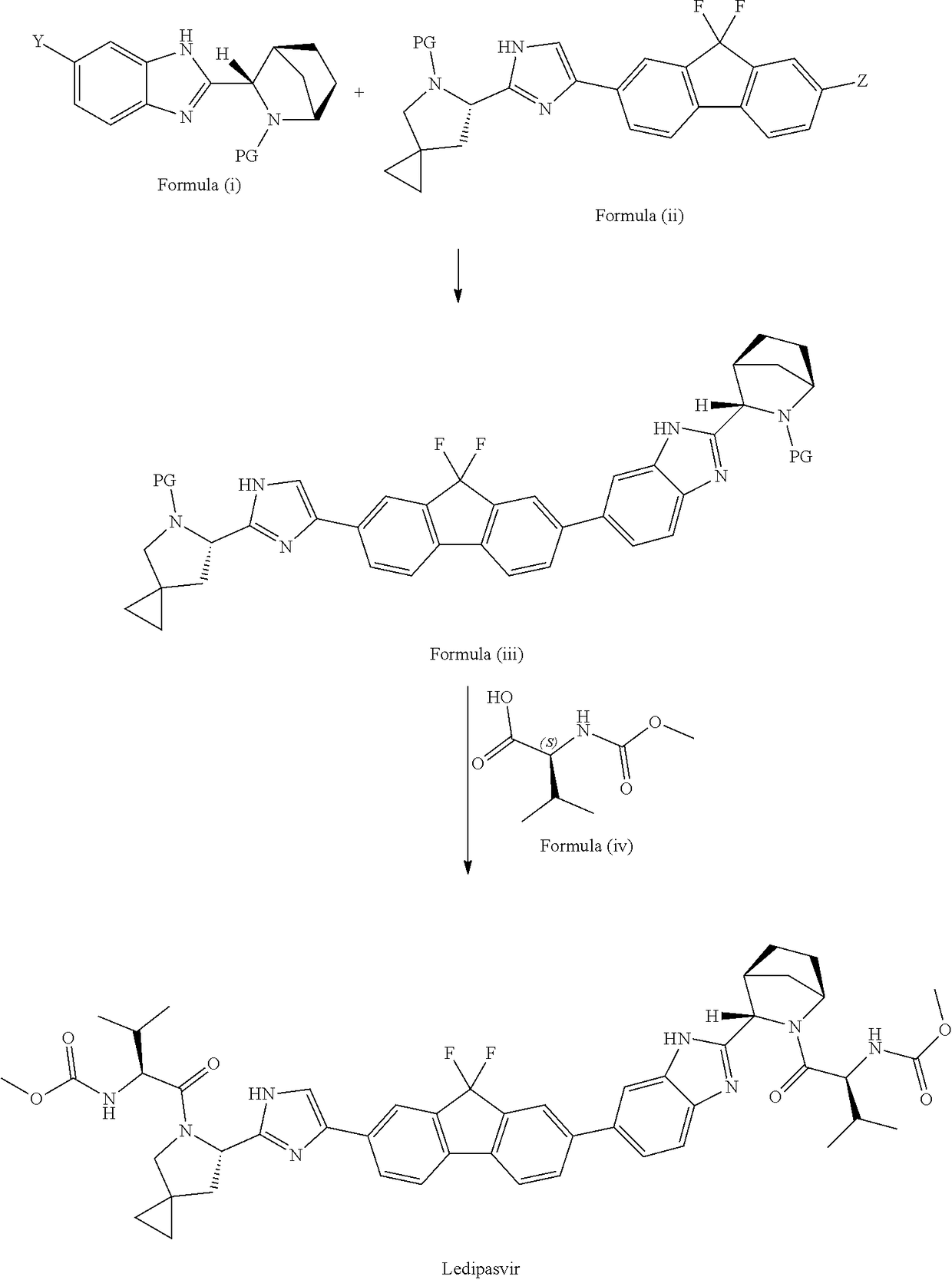Process for the preparation of ledipasvir and intermediates thereof
a technology of ledipasvir and ledipasvir, which is applied in the field of process for the preparation of antihcv compound ledipasvir, can solve the problems of limited usefulness of effects, insufficient viral elimination from the body, and substantial limitations in efficacy and tolerability
- Summary
- Abstract
- Description
- Claims
- Application Information
AI Technical Summary
Benefits of technology
Problems solved by technology
Method used
Image
Examples
example 1
on of 2,5-dioxopyrrolidin-1-yl 2-(((benzyloxy)carbonyl)amino)-3-methylbutanoate (Formula 10′)
[0045]
[0046]2-(((benzyloxy)carbonyl)amino)-3-methylbutanoic acid (65 g, 259 mMol), tetrahydrofuran (450 ml) were charged to a flask. N-hydroxy succinimide (33.3 g 285 mMol) was added to the reaction mass. Reaction mass was stirred for 10 mins. Dimethyl amino pyridine (DMAP, 1 g) was added to the reaction mass. Reaction mass was stirred and temperature of reaction mass was decreased to 5° C. Solution of DCC in THF (42.5%, 200 ml) was added dropwise to the reaction mass over a period of 45 minutes at 5° C. Reaction mass was stirred for 20 hours. Obtained solid was filtered; solvent was stripped off under reduced pressure. Solid was washed with heptane (3×250 ml), to get crude material (2,5-dioxopyrrolidin-1-yl 2-(((benzyloxy)carbonyl)amino)-3-methylbutanoate) with sufficient purity. Yield 85.5 g.
[0047]1H NMR (DMSO-D6, 400 MHz): δ 1.02 (d, 6H), 2.24 (m, 1H), 2.82 (s, 4H), 4.37 (q, 1H), 5.09 (s,...
example 2
on of 6-(5-(7-bromo-9,9-difluoro-9H-fluoren-2-yl)-1H-imidazol-2-yl)-5-azaspiro[2.4]heptane hydrochloride (Formula 7′)
[0051]
[0052]tert-butyl 6-(5-(7-bromo-9,9-difluoro-9H-fluoren-2-yl)-1H-imidazol-2-yl)-5-azaspiro[2.4]heptane-5-carboxylate (5 g, 9.2 mMol), Ethyl acetate (50 ml) were charged to flask. Solution of HCl in ethyl acetate (10%) was added dropwise to the reaction mass. The reaction mass was stirred for 2 hours at 55-60° C. Reaction mass was cooled to 20° C., filtered the solid 6-(5-(7-bromo-9,9-difluoro-9H-fluoren-2-yl)-1H-imidazol-2-yl)-5-azaspiro[2.4]heptane as HCl salt. Yield 4.6 g.
[0053]1H NMR (MeOD, 400 MHz): δ 0.87 (s, 2H), 0.98 (s, 2H); 2.38 (m, 1H); 2.82 (m, 1H); 3.70 (d, 1H); 5.37 (1H), 7.42-8.15 (m, 7H).
[0054]FTIR (KBr): 3400, 2874, 1634, 1545, 1467, 1242, 1047, 821 cm−1
[0055]MS (EI): C22H19BrClF2N3 Exact mass: 477.0 & 499.0 (Cl−) observed mass: 442.0 (without chloro pattern), 444.1 (with Bromo pattern)
example 3
on of 2-((1S,3R,4R)-2-azabicyclo[2.2.1] hepatan-3-yl)-5-(4,4,5,5-tetramethyl-1,3,2-dioxaborolan-2-yl)-1H-benzo[d]imidazole hydrochloride (Formula 9′)
[0056]
[0057]1,4-dioxane (100 ml) was charged to flask. Flask was cooled to 0° C. Water (5 ml) was added to the flask. Oxalyl chloride (25 g) was added drop wise to the reaction mixture. Reaction mass was stirred for 30 minutes. (1S,3R,4R)-tert-butyl 3-(5-(4,4,5,5-tetramethyl-1,3,2-dioxaborolan-2-yl)-1H-benzo[d]imidazole-2-yl)-2-azabicyclo[2.2.1]heptane-2-carboxylate (10 g, 22.7 mMol) was added to reaction mass. Reaction mass was stirred for 30 minutes at 55-60° C. Ethyl acetate (10 ml) was added to the reaction mass. Reaction mass was stirred for 30 minutes at 0-5° C. Obtained solid was filtered under vacuum. Solid was dried overnight under vacuum to give 2-((1S,3R,4R)-2-azabicyclo[2.2.1] hepatan-3-yl)-5-(4,4,5,5-tetramethyl-1,3,2-dioxaborolan-2-yl)-1H-benzo[d]imidazole hydrochloride salt. Yield 7.4 g
[0058]1H NMR (MeOD, 400 MHz): δ 1.39...
PUM
 Login to View More
Login to View More Abstract
Description
Claims
Application Information
 Login to View More
Login to View More - R&D
- Intellectual Property
- Life Sciences
- Materials
- Tech Scout
- Unparalleled Data Quality
- Higher Quality Content
- 60% Fewer Hallucinations
Browse by: Latest US Patents, China's latest patents, Technical Efficacy Thesaurus, Application Domain, Technology Topic, Popular Technical Reports.
© 2025 PatSnap. All rights reserved.Legal|Privacy policy|Modern Slavery Act Transparency Statement|Sitemap|About US| Contact US: help@patsnap.com



